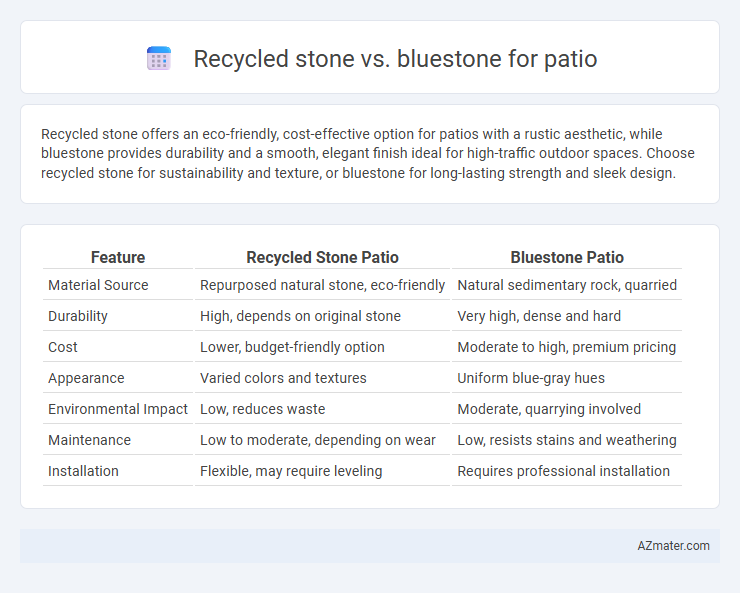Recycled stone offers an eco-friendly, cost-effective option for patios with a rustic aesthetic, while bluestone provides durability and a smooth, elegant finish ideal for high-traffic outdoor spaces. Choose recycled stone for sustainability and texture, or bluestone for long-lasting strength and sleek design.
Table of Comparison
| Feature | Recycled Stone Patio | Bluestone Patio |
|---|---|---|
| Material Source | Repurposed natural stone, eco-friendly | Natural sedimentary rock, quarried |
| Durability | High, depends on original stone | Very high, dense and hard |
| Cost | Lower, budget-friendly option | Moderate to high, premium pricing |
| Appearance | Varied colors and textures | Uniform blue-gray hues |
| Environmental Impact | Low, reduces waste | Moderate, quarrying involved |
| Maintenance | Low to moderate, depending on wear | Low, resists stains and weathering |
| Installation | Flexible, may require leveling | Requires professional installation |
Introduction to Patio Stone Options
Recycled stone offers an eco-friendly patio solution by repurposing materials like crushed concrete and reclaimed aggregate, reducing environmental impact while providing durability and unique textures. Bluestone, a natural sandstone known for its rich blue-gray hues and slip-resistant surface, delivers a classic aesthetic favored for elegant, long-lasting patios. Choosing between recycled stone and bluestone depends on factors such as budget, design preferences, sustainability goals, and the intended use of the outdoor space.
What is Recycled Stone?
Recycled stone for patios is made from repurposed materials like crushed concrete, brick, and natural stone remnants, offering an eco-friendly alternative to traditional stone. It provides excellent durability and cost-effectiveness while reducing environmental impact by diverting waste from landfills. Unlike bluestone, which is a specific natural sandstone known for its uniform blue-gray color and smooth texture, recycled stone varies in appearance and composition, allowing for more diverse design options in patio construction.
What is Bluestone?
Bluestone is a dense, durable natural stone commonly quarried from sandstone or limestone formations, prized for its rich blue-gray color and textured surface. It is frequently used in patios due to its slip-resistant properties and ability to withstand variable weather conditions. Bluestone's natural variability and strength make it an enduring choice compared to recycled stone, which often lacks uniformity and the same level of durability.
Environmental Impact: Recycled Stone vs Bluestone
Recycled stone patios significantly reduce environmental impact by reusing existing materials, minimizing quarrying, and lowering carbon emissions associated with extraction and transportation. Bluestone, sourced from natural quarries, involves intensive mining processes that disrupt ecosystems and contribute to habitat loss. Choosing recycled stone supports sustainable landscaping by promoting resource conservation and reducing landfill waste compared to the environmental cost of harvesting new bluestone.
Cost Comparison: Recycled Stone vs Bluestone
Recycled stone generally offers a more budget-friendly option for patios, costing approximately $2 to $5 per square foot compared to bluestone, which ranges from $8 to $15 per square foot. Installation costs for recycled stone tend to be lower due to its irregular shapes and easier handling, whereas bluestone requires skilled labor for precise cutting and fitting. Maintenance expenses also favor recycled stone, as its rugged durability reduces long-term upkeep compared to the more delicate bluestone surface.
Durability and Longevity
Recycled stone offers moderate durability but may contain varying materials that affect its longevity, making it less consistent than natural stone options. Bluestone is renowned for its exceptional hardness and resistance to weathering, ensuring a patio that remains structurally sound and visually appealing for decades. Choosing bluestone guarantees superior long-term performance and minimal maintenance compared to recycled stone.
Aesthetic and Design Versatility
Recycled stone offers a unique, rustic aesthetic with varied textures and colors, making it ideal for eco-friendly, eclectic patio designs. Bluestone provides a sleek, uniform appearance with smooth surfaces and shades of blue-gray that complement modern and traditional outdoor spaces. Both materials enhance design versatility, but recycled stone excels in creating a natural, weathered look, while bluestone lends a refined, elegant finish.
Installation Differences
Recycled stone patios typically require a compacted base of crushed concrete or asphalt, providing a stable and eco-friendly foundation, while bluestone patios often need a sand or mortar bed for precise leveling and enhanced durability. Installation of recycled stone is generally faster and more cost-effective due to its irregular shapes and smaller size, whereas bluestone's uniform slabs demand meticulous cutting and fitting to achieve a polished appearance. Drainage considerations also vary; recycled stone allows for better permeability, whereas bluestone installations often incorporate slope adjustments to prevent water pooling.
Maintenance Requirements
Recycled stone patios demand minimal upkeep, requiring occasional sweeping and sealing to maintain durability and prevent weed growth. Bluestone patios need regular cleaning to avoid staining and periodic sealing to enhance resistance against weathering and discoloration. Both materials benefit from prompt removal of debris to preserve their appearance and structural integrity over time.
Which Stone is Best for Your Patio?
Recycled stone offers an eco-friendly option with durability and natural variation, ideal for sustainable patio projects, while bluestone provides a dense, non-porous surface known for its slip resistance and classic blue-grey hues. Bluestone's superior durability against weather and heavy foot traffic typically outperforms recycled stone in longevity, making it a preferred choice for high-use patios. Choosing between recycled stone and bluestone depends on balancing environmental impact preferences with the desired aesthetic, maintenance level, and budget for your patio space.

Infographic: Recycled stone vs Bluestone for Patio
 azmater.com
azmater.com